How to Play Basic/Easy Ukulele Chords:
You wake up one day and randomly pick an instrument to either accompany yourself while singing for an event or a concert or to impress your favourite person or to entertain your audience in a party or for any other reason, ukulele can be your potential best friend. This blog is about the Ukulele Chords and how to play them.
Yes, you heard me right! The ukulele is extremely travel friendly, easy to tune, comes with wider varieties to adapt your preference of the pitch, reasonable price, doesn’t hurt your fingers much and the reasons are pretty endless. Though the ukulele is small and fun to play, us the musicians can create magic with this instrument.

There’s something about the ukulele that just makes you smile. It makes you let your guard down. It brings out the child in all of us. – Jake Shimabukuro.
The Process Towards Chords:
Now having said that I am pretty sure as and when you randomly pluck different strings, play many strings together, use the ukulele as a bongo (been there done that) and what not! Even before knowing what’s a note/scale/chords/techniques, you experiment around and enjoy whatever sound you make. And now to streamline it, we start with music theory where we identify what’s a note and how to pluck a particular string in your right hand and fret your left hand accordingly to get the intended note.
After knowing your fret lines on the ukulele, you start playing the scales which is a set of notes are in a particular order. Let’s say C major scale where there are no sharps and flats which makes our life hassle-free (for now) and start playing the scale a couple of times to get yourselves comfortable with the notes of the scale, flexibility on your hands, Sight-reading.
Yes! Now let’s play a song! At this point you play a song(melody) either through listening or with the tab representation and you will end up having your first Eureka moment!! Now you feel like you want add more harmony and depth to your playing. So here comes our hero the chords! Chords are a combination of three or more notes played simultaneously which contributes to harmony and emotions!
Chord Formation:
There are myriad number of chord formation possible and good news everyone you don’t have to by-heart the position! Chords are formed from the notes of the scale. Major chord is formed by the root, Major third and the perfect fifth (1-3-5).
Minor chord is formed by the root, Minor third and the perfect fifth(1-3b-5). There are many other chords like diminished, augmented, seventh etc but let’s keep the scope here with major and minor chords.
Major and Minor Chords in Ukulele:
Ukulele standard tuning is G-C-E-A where A is the first string, E is the second string, C is the third string and G is the fourth string. Frets are vertical strips of metal on your ukulele and they have the names like fret1, fret 2 etc. To hold a chord, press the notes of the particular chord with the tip of your fingers close to the fret line till the sound is wobble free and clear. The following picture shows a picture of parts of the ukulele.
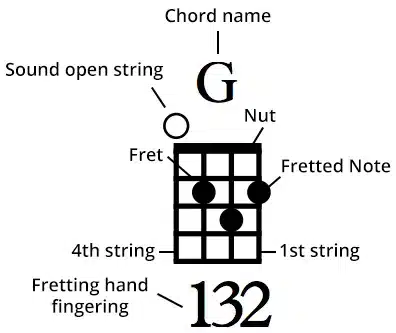
Chord Charts:
Chord chart gives a visual representation of four strings of the ukulele with only the first five frets.
O – A circle on the string means to play that string in an open position
X – An x on the string means mutes the string
1 = Index finger
2 = Middle finger
3 = Ring finger
4 = Pinky finger
Let’s see the major and minor chords that are possible in C major scale.

Did You Know?
The ukulele was invented in Hawaii in the 1880s, it is believed to have descended from an instrument called a machete brought to the Hawai’ian islands by Portuguese immigrants.
C Major Chord:
The notes of the C major chord are C, E, G. It uses only one finger to fret. Open G, Open C, Open E, third fret on A string. Below is the given chord chart representation. Follow the chord chart to choose finger placement in your left hand. On the right hand you can choose to strum or fingerpick as you feel like. The following picture gives the chord chart for C major.
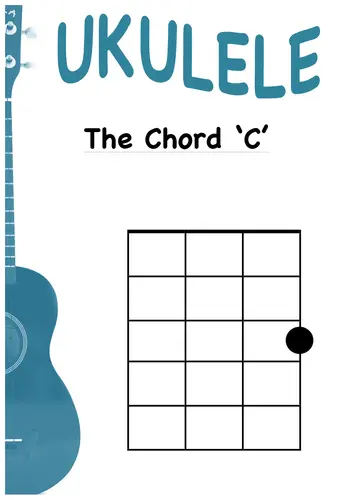
D Minor Chord:
The notes of the D minor chord are D, F, A. It uses three fingers to fret. Second fret on G, Second fret on C, First fret on E, open A string. Below is the given chord chart representation. Follow the chord chart to choose finger placement in your left hand. On the right hand you can choose to strum or fingerpick as you feel like. The following picture gives the chord chart for D minor.
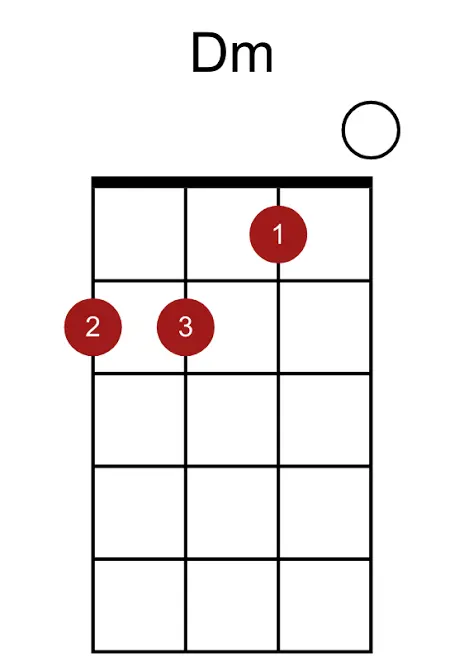
E Minor Chord:
The notes of the E minor chord are E, G, B. It uses three fingers to fret. Open G, Fourth fret on C, Third fret on E, Second fret on A string. Below is the given chord chart representation. Follow the chord chart to choose finger placement in your left hand. On the right hand you can choose to strum or fingerpick as you feel like. The following picture gives the chord chart for E minor.
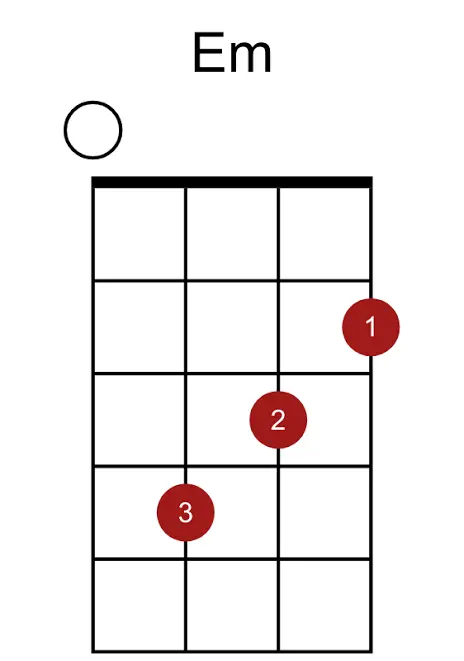
F Major Chord:
The notes of the F major chord are F, A, C. It uses two fingers to fret. Second fret on G, Open C, First fret on E, Open A. Below is the given chord chart representation. Follow the chord chart to choose finger placement in your left hand. On the right hand you can choose to strum or fingerpick as you feel like. The following picture gives the chord chart for F major.
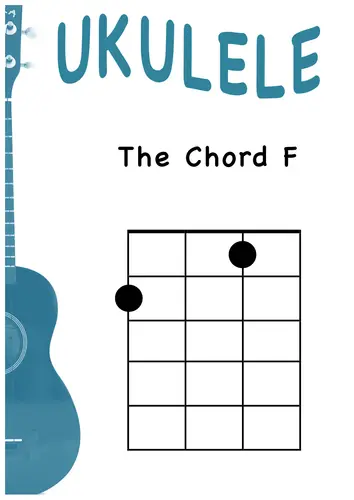
G Major Chord:
The notes of the G major chord are G, B, D. It uses three fingers to fret. Open G, Second fret on C, Third fret on E, Second fret on A. Below is the given chord chart representation. Follow the chord chart to choose finger placement in your left hand. On the right hand you can choose to strum or fingerpick as you feel like. The following picture gives the chord chart for G major.
A Minor Chord:
The notes of the A minor chord are A, C, E. It uses only one finger to fret. Second fret on G string, Open C, Open E, Open A. The chord chart and tab representation are given as follows. Follow the chord chart to choose finger placement in your left hand. On the right hand you can choose to strum or fingerpick as you feel like. The following picture gives the chord chart for A minor.
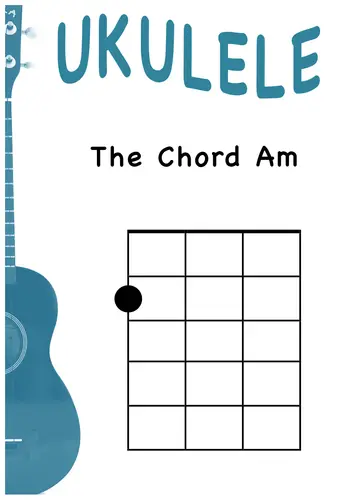
More on Chords:
There are several more major, minor chords that are possible. Now with the idea that is given in this article. You can figure out the chord position all by yourself. When you start learning ukulele. Understand the tonality of the chords that are possible in the scale. After knowing the notes choose the left finger position in accordance and strum or pick on your right hand.
Do you want to know the top 7 reasons for you to learn Ukulele?
FAQs
Mention a few easy Ukulele chords to learn?
Major C, F, G and A minor are a few of the easiest Ukulele chords to learn.
Is there a pictorial representation of Ukulele chords?
The blog above contains details and pictorial representation of the Ukulele Chords.
Mention a difference between Ukulele chords and Guitar Chords?
A guitar is tuned E-A-D-G-B-E. Whereas a ukulele is tuned, G-C-E-A.
Can guitar capo be used on ukulele?
Yes you can use a Guitar capo on Ukulele. However it is advised that you use Capos specifically designed for Ukulele.
How can I switch between ukulele chords smoothly?
While strumming, on the upbeat of the last strum on the chord, remove all of your fingers from the fret. This will give you ample time to move to the next chord.
































